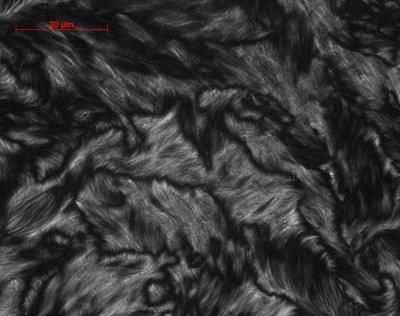Scaring off Mosquitoes
Total synthesis of gaur acid reveals the spatial structure of this proposed yellow-fever mosquito repellant
Advertisement
Mosquito bites are more than just annoying-in tropical regions they can be deadly because these little pests spread tropical diseases such as malaria and yellow fever. Recently a compound that is thought to serve as a landing and feeding deterrent for the yellow-fever-spreading Aedes mosquito was discovered in the secretions of the gaur, an Asian wild ox. By using a new synthetic strategy, an American team has succeeded in producing this natural substance, called gaur acid, in the laboratory, thereby also confirming its exact spatial structure.
The basic structure of gaur acid was previously known: the central structural element of the molecule is a ring made of four carbon atoms and one oxygen atom. Each of the carbons neighboring the oxygen carries a side chain, but these are not identical. It was known how these two side chains are oriented relative to each other. What remained a mystery was the absolute configuration, the arrangement of all the atoms in space. This is very important, since often only one of the so-called mirror images is biologically active.
The team headed by P. A. Evans at Indiana University produced gaur acid in the laboratory using a newly developed reaction scheme. The first pivotal step is a rhodium-catalyzed allylic etherification. The components involved are derivatives of the two future side chains, which are first linked (etherified) with an oxygen atom to form a long chain. In a second fundamental reaction step, the alkene tails on the side chains are closed to form a ring (ring-closing metathesis). The first step is especially tricky. One of the building blocks is added to the reaction mixture as a copper alkoxide, and if the copper also carries a specific ligand -trimethylphosphite - the reaction is stereospecific, meaning that only one of the possible spatial structures is preferentially formed. This is determined by the configuration of the starting materials. Comparison of the optical rotation of natural gaur acid with that of the synthetic compound allowed the chemists to determine which absolute configuration is the correct one.
"Our new stereospecific reaction scheme for the synthesis of cyclic ethers is very flexible," says Evans. "By choosing different building blocks, we can control both the ring size and the spatial arrangement of the side chains. The total synthesis of gaur acid demonstrates the potential utility of this method."
Other news from the department science

Get the chemical industry in your inbox
By submitting this form you agree that LUMITOS AG will send you the newsletter(s) selected above by email. Your data will not be passed on to third parties. Your data will be stored and processed in accordance with our data protection regulations. LUMITOS may contact you by email for the purpose of advertising or market and opinion surveys. You can revoke your consent at any time without giving reasons to LUMITOS AG, Ernst-Augustin-Str. 2, 12489 Berlin, Germany or by e-mail at revoke@lumitos.com with effect for the future. In addition, each email contains a link to unsubscribe from the corresponding newsletter.




























































